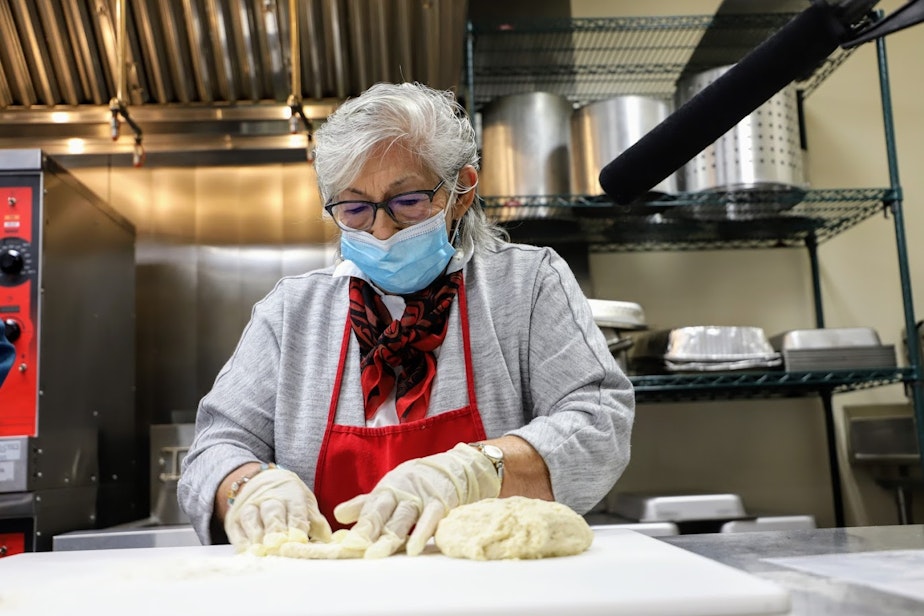Giving thanks, the Duwamish way

Turkey, stuffing and sides are the main attractions in most Thanksgiving meals.
But one Seattle man has developed a meal that incorporates Pacific Northwest Indigenous foods to tell the story of the Duwamish people.
Inside the kitchen of the Duwamish Longhouse in West Seattle, Cecile Hansen has just put a piece of dough into the fryer. David Lee, with kitchen tongs in hand, waits for his cue.
“When it starts to get brown around the corner, you know it’s okay,” said Hansen, chairwoman of the Duwamish Tribe.
Lee, founder of the nonprofit FoodCircle, points to the browning edges. Hansen gives the go-ahead and Lee flips the dough. Before long, he fishes it out of the fryer.
“What we’re going to do,” Lee said, “is combine strips of frybread into regular stuffing.”

Sponsored
He was describing the special Thanksgiving meal they’re preparing this week. The menu is a blend of familiar dishes and Indigenous foods. There’s wild salmon clam chowder, fiddle head and kale salad with berry salal dressing. And the stuffing will be tossed with frybread.
“Are you saying these are going into the dressing?” Hansen asked, making sure she heard right.
“I’ve never heard of it. White man’s way,” she mumbled.
“Is she making jokes?” Lee asked.
“Yeah, I said white man’s way,” Hansen said.
Sponsored
Lee joined in on the laughter.
“I’ve never seen this before,” Hansen said.
“Well, no one’s ever done this before,” Lee said.
Lee and Hansen are friends and collaborators in this holiday feast. Lee’s nonprofit focuses on food for change.
“I’m doing this for us,” Lee explained. “And when I say 'us,' I mean my European or non-Native friends and community members, because we need to recognize the history of this city.”
Sponsored
He said the Thanksgiving story often focuses on the white settlers; the part involving the Natives, overlooked. That the newcomers wouldn’t have survived without the help and hospitality of their host, the Duwamish Tribe.
“The Duwamish were the first Indigenous people here before anybody showed up here in Seattle,” Hansen said.
Hansen is the great-great-grand niece of Chief Seattle, the city’s namesake and the tribal leader who welcomed the early settlers. When it comes to food, Hansen said the tribe relied on the land and the waters for sustenance.
“They were blessed to know how to go out, to gather and to fish and to hunt,” she said. “And somebody must’ve taught them a long, long time ago how to prepare their meals.”
The settlers occupied the land, and in short time changed the communities. Under the Treaty of Point Elliott, the Duwamish Tribe gave up their homeland, which was much of King County. In return, they were promised their own reservations and guaranteed fishing and hunting rights.
Sponsored
But those were empty promises. For decades, the tribe struggled to get federal recognition.
“Finally, President Clinton recognized them … on the eve of his departure,” Lee said.
But the celebration was short-lived. “The next day George W. Bush revoked that recognition.”
The tribe has appealed multiple times, but without success. There are about 600 enrolled members. Without federal recognition, the tribe lacks access to funding and services. It’s the story Lee wants to share when people open their Thanksgiving meal.
“What’s interesting about this myth of Thanksgiving is that it has this Native element to it and yet we don’t celebrate it or acknowledge it.”
Sponsored
Especially what happened afterward.
Without a reservation or land, one physical reminder of the tribe’s presence is the longhouse and cultural center. It was completed in 2009, across the street from what used to be one of the largest villages along the Duwamish River.

